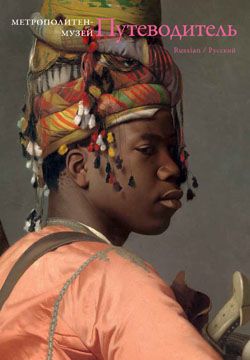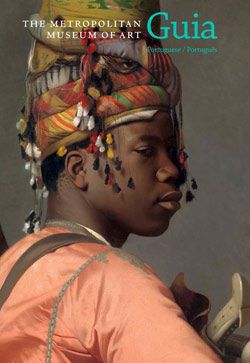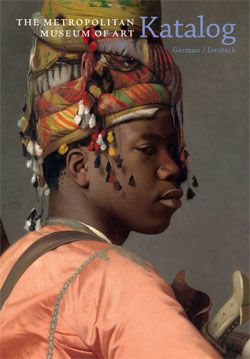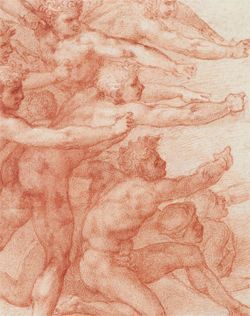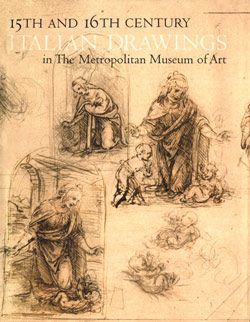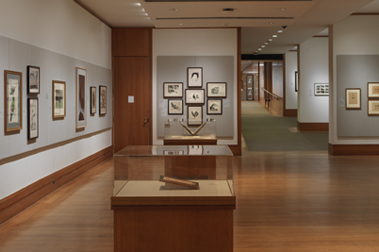Studies for the Libyan Sibyl (recto); Studies for the Libyan Sibyl and a small Sketch for a Seated Figure (verso)
Michelangelo Buonarroti Italian
Not on view
This double-sided sheet of closely observed life studies is the most magnificent drawing by Michelangelo in North-America, purchased by the Metropolitan Museum of Art on August 8, 1924 (its acquisition being voted by the museum’s acquisitions committee on June 9, 1924), in great part thanks to negotiations by the eminent painter, John Singer Sargent, with the widow of Aureliano de Beruete, its previous owner (file no. D7950, Archive Department of Drawings and Prints, The Metropolitan Museum of Art). The much smaller than life-size studies on the famous recto side of the Metropolitan sheet were clearly done from a young male assistant posing in the artist’s studio, being preparatory for the design of the Libyan Sibyl, the monumental enthroned female figure painted in fresco on the north-east end of the Sistine Ceiling. The Libyan Sibyl was the last of the seers to be frescoed on the north part of the vault, executed in a scale that is about three times life-size (the overall area of this part in the fresco measures 4.54 meters by 3.80 meters); she is clothed except for her powerful shoulders and arms, and wears an elaborately braided coiffure. Her complex pose in the fresco, evidently requiring study in numerous drawings, plays on the arrested motion of her stepping down from the throne, while holding an enormous open book of prophecy which she is about to close.
Sketched in soft black chalk, the verso of the double-sided Metropolitan sheet was possibly drawn before the better-known recto side with its meditated red chalk studies; many of Michelangelo’s drawings for the early parts of the Sistine Ceiling are in a similarly soft black-chalk technique (examples of early Sistine studies in soft black chalk are British Museum inv. 1859,0625.567, London; Teylers Museum inv. A 18 verso, Haarlem; Casa Buonarroti inv. nos. 64 F and 75 F, Florence; Musée du Louvre Département des Arts Graphiques inv. 860, Paris; Biblioteca Reale inv. 15627 D.C., Turin.), while a preponderance of sheets done for the later parts of the frescoes are in red chalk. The verso of the Metropolitan sheet portrays at center, in profile the large nude seated figure of the sibyl (here, the softer anatomical forms may be feminine, rather than masculine as they evidently are in the case of the studies on the recto), at upper right a very summary design of a much smaller figure in three-quarter view facing left (its style generally resembles the motifs in the "Oxford Sketchbook": see Ashmolean Museum nos. 1846.45 to 1846.52), and at lower right the detail study of the sibyl’s right knee. The main study in red chalk, on what is today considered the recto of the Metropolitan double-sided sheet, portrays the seated youth with head in profile, bent arms and upper body turned in an elegant contrapposto stance, to display the formidable musculature of his back in a rear view. Michelangelo considered the position of the shoulders turning into the depth of space, with especial attention, indicating also with two small circles the prominence of the supraspinatus muscles (the accents with tiny touches of white chalk on the left shoulder are likely a later retouching, but create a most intense highlight).
The sequence of execution of the surrounding motifs on the recto, also done in red chalk, is much less clear, and one may venture to guess that, at left, the reprise of the head in profile and the rough sketch of the torso and head were drawn before the main study (given that parts of their outlines seem to lie underneath the main study), while the highly rendered motifs of the left hand at lower center and the three reprises of the left foot and toes at right probably followed the main study on the sheet. The manner of the weight-bearing on the toes of the sibyl’s left foot was crucial for the overall design of the figure’s contrapposto pose, and explains the multiple studies of this detail on the Metropolitan sheet. The facial features on the large head at lower left in the recto seem closer to those of the Libyan Sibyl in the final fresco, than the face of the youth in the main study. The recto of a sheet in the Ashmolean Museum (no. 1846.43; Fig. 2), Oxford, dedicated to studies for the Sistine Ceiling and sketches for the Tomb of Pope Julius II, represents at center the attendant young boy genius who is seen to the immediate left of the frescoed Libyan Sibyl, as well as at lower left the sibyl’s right hand, both motifs executed in red chalk. While the overall dimensions of the Oxford sheet (28.6 x 19.4 cm) are similar to those of the Metropolitan sheet, the hue of the red chalk seems brighter and slightly orange; nevertheless, it is clear that the Oxford and New York sheets are very close companions, probably from the same sketchbook, without their necessarily being (in the present author’s opinion) halves of the same sheet, as an earlier generation of scholars suggested (summary of discussion in Joannides 2007, p. 120).
The scientific findings which emerged during the cleaning of Michelangelo’s Sistine frescoes (1984-1990; published in Mancinelli 1994) provide a precise, though often overlooked context in which to consider the dating and function of the Metropolitan Museum studies. Given that the great artist painted the enormous vault of the chapel from the west to east end -- that is, from above the entrance to above the site of the altar -- in two campaigns demarcated by the erection of scaffolding (or pontate), as is suggested by both documents and a variety of recently emerged physical data (for which see Mancinelli 1994, pp. 16-22), the monumental Libyan Sibyl belongs to the latter phase of work on the project. At this point, Michelangelo’s technical virtuosity as a fresco painter was at its height, having made a rough and inexperienced beginning in 1508 when the first scene of the vault he frescoed, The Deluge, grew mold because of incorrectly prepared intonaco (this fine surface plaster was used too watery; see also Condivi 1553). The most difficult technique of painting is possibly that of fresco, as it requires speed of execution onto the wet plaster before it sets and great self-confidence; writers of art treatises from the fourteenth to the eighteenth century judged the medium of fresco to be supreme, precisely because of the technical virtuosity it demanded (Bambach 1999); as Michelangelo would himself later complain to his biographer Giorgio Vasari: "Fresco painting is not an art for old men." (Vasari 1568).Although the chronology of the Sistine Ceiling is debated, the first phase of work, or pontata, was done between late summer – perhaps late July -- of 1508 (the contract for the Sistine frescoes dates to May 10, 1508; see Bardeschi Ciulich and Barocchi 1970) and late August 1510, and ended with the painting of the Creation of Eve; while the second pontata and final phase of work probably began some time after January 1511 (the winter months are not good for fresco-painting), concluding on October 31, 1512 with the unveiling of the Chapel (see Gilbert 1994). The recto of the Metropolitan Museum study can be dated with great probability to the winter of 1511, when Michelangelo could draw rather than paint in fresco (he returned to Rome, from Bologna, by January 11, 1511), and would have been prepared at the beginning of the second pontata, that is, soon after the great artist had moved his scaffolding for the second (and final) time to paint. The gigantic figure of the Libyan Sibyl, together with her throne and attendants, was frescoed onto the large concave surface of the vault in twenty days of work (the fresco is comprised of 20 giornate, or patches of fine surface plaster), and the complex design was transferred by the laborious technique of spolvero (a cartoon or full-scale drawing transferred by means of pricking and pouncing the outlines; see Bambach 1994).
The Metropolitan study is done with a red-chalk of slightly purplish hue sharpened to a point for the fine contours of the figure and some of the interior hatching, but it was also at times applied with the side of the stick; the red chalk medium was especially suited for the particularized, highly naturalistic study of anatomical detail. Although Michelangelo had begun to use red chalk in the early 1490s (See C.C. Bambach, "La virtù dei disegni del giovane Michelangelo", in Michelangelo 1564-2014, ed. by C. Acidini, Rome 2014), his greatest accomplishments with this medium are connected with the later parts of the Sistine Ceiling. Yet the group of red chalk studies for the Sistine has also been among the most greatly contested of Michelangelo’s drawings in terms of attributions. The closest companions in style and technique to the red-chalk Metropolitan Libyan Sibyl are the studies on the sheet at the Ashmolean Museum (Fig. 2), as well as three others at the Teyler Museum, Haarlem (inv. nos. A16 recto, A20 recto-verso, and A27 recto-verso). Two of these Teyler sheets (A20 and A 27) are drawn, in fact, with a red chalk of closely similar purplish hue as that employed for the Libyan Sibyl on the recto of the Metropolitan Museum sheet. Clearly autograph, the sketches on the better preserved verso of the Metropolitan sheet are not ever mentioned by the scholars rejecting the attribution of the recto studies to Michelangelo(Perrig 1976; Perrig 1991; Zöllner et al. 2008). This verso exhibits a similar type of handling --with loose, impressionistic hatching and contours, rather than finely detailed-- as most of the soft black-chalk studies for the early parts of the Sistine Ceiling (for example, the sheets British Museum inv. 1859,0625.567, London; Teylers Museum inv. A 18 verso, Haarlem; Casa Buonarroti inv. nos. 64 F and 75F, Florence; Musée du Louvre Département des Arts Graphiques inv. 860, Paris). The late sixteenth-century copy in red chalk after the Metropolitan Libyan Sibyl at the Uffizi (inv. no. 2318 F), Florence, is of nearly the same size, but is of remarkably inferior quality of execution, omitting also the two anatomical notations of circles on the shoulders and the tiny white chalk accents. Moreover, the drawn copy rearranges the positioning of the individual motifs, introduces the right foot of the sibyl (which is absent in the recto of the Metropolitan sheet), and records the abrupt terminus of outlines in the study of the toe. As the Uffizi copy emulates defects of condition in the original Metropolitan sheet (especially the outlines of the hole in the original paper support), it can be deduced that it directly derives from the Metropolitan sheet.
The verso sketches on the Metropolitan Museum sheet have always rightly been recognized as by Michelangelo, and the "no. 2i ." inscribed at lower center adds further proof, as it fits precisely into a numerical sequence found on many other drawings by the great artist that have an early Buonarroti family provenance (see Bambach 1997). The annotation at lower left on the recto regarding the artist’s surname, here spelled in the form of "bona Roti" is also signficant in view of the corpus of drawings by Michelangelo and his school which bear this annotation by the so-called "Bona Roti collector," as Paul Joannides has baptized him. In any case, important groups of drawings inherited by the Buonarroti family appears to have been dispersed between ca. 1684 and 1799, probably by the senatore Filippo Buonarroti (Joannides 2007). The paraph in pen and dark brown ink inscribed at lower center on the recto of the Metropolitan sheet is often mistaken as a mark of ownership by the collector Everhard Jabach (1618-1695), of Cologne and Paris (De Tolnay1975; Logan and Plomp 2005) rather, it closely resembles the paraphs scribbled on sheets of drawings in the Real Academia de San Fernando, Madrid, and which were part of a large group of drawings acquired in 1775 from the widow of the painter Andrea Procaccini (1671-1734), who had died at La Granja de San Ildefonso and who had in turn inherited them from his master, Carlo Maratti (1625-1713; see Mena Marqués 1982). Although the overall condition of this double-sided sheet is very good, it is somewhat different for each face of the paper; the original off-white hue of the paper is still nearly intact on the verso, but is considerably darkened on the recto; this is apparently due to prolonged exposure to light, and, as noted in 1925 by Bryson Burroughs (the curator who bought the drawing for the Met), the red chalk studies on the recto were "fixed" with a solution of shellac in alcohol, which has intensified the differences of light and shade (Bryson Burroughs 1925). The recto also exhibits stains of brown wash at lower right; the triangular loss on the original support toward the center of the right border (if the sheet is regarded from the recto) is the result of very early damage, being made up and toned in restoration after 1951.
(Carmen C. Bambach)
#9917. Libyan Sibyl
This image cannot be enlarged, viewed at full screen, or downloaded.
This artwork is meant to be viewed from right to left. Scroll left to view more.































